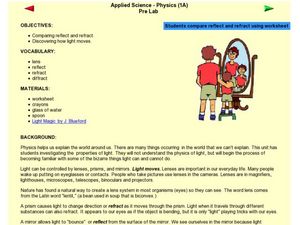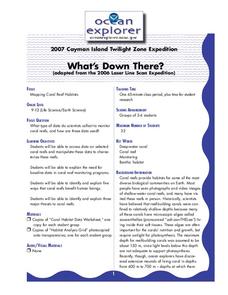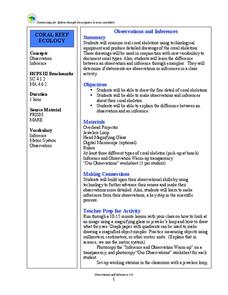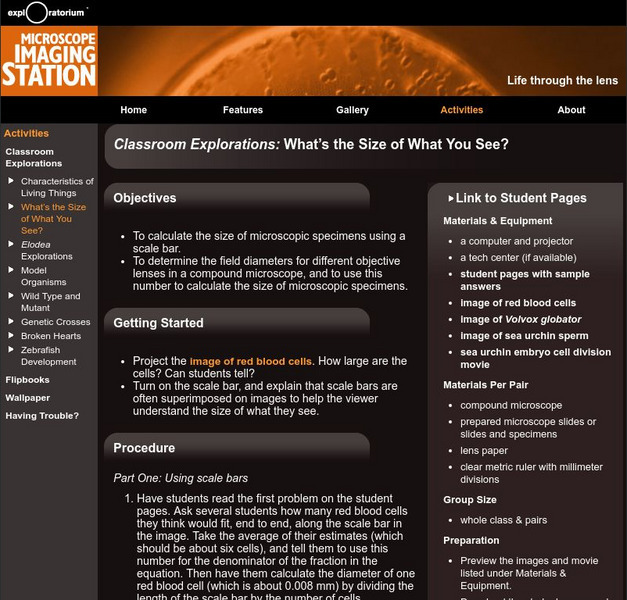Curated OER
HOW SMALL AM I? THE SCIENCE OF NANOTECHNOLOGY
High schoolers study nanotechnology and investigate the dimensions of a nanoscale. In this nanometer study lesson students will see how truly small a nanometer is by measuring things such as a piece of hair.
Curated OER
Save A Reef!
Students identify the major threats to coral reefs and the ways that they benefit from humans. In this coral reef conservation lesson students create a public education program on coral reefs.
Curated OER
Applied Science-Science and Math Post Lab
Pupils explore magnification. In this science skills observation lesson, students make a hand lens using a wire loop and a small amount of water.
Curated OER
Applied Science - Science and Math Pre Lab
Students explore human senses. In this applied Science lesson, students utilize their senses to distinguish various objects. Students explain their descriptions.
Curated OER
Reflect and Refract
Students explore light. In this properties of light lesson, students define the terms refract, reflect, and diffract after listening to the teacher's description. Students listen to the book Light Magic and observe a spoon in a glass of...
Curated OER
Let's Go to the Video Tape!
Pupils examine biological diversity and see how it relates to the concepts of variety and relative abundance. In this investigative instructional activity students view a video on biodiversity and complete an activity.
Curated OER
What's Down There?
Students analyze data on coral reefs and use this to help characterize reefs. In this mapping coral reefs lesson students identify and explain the major threats to coral reefs.
Curated OER
Design a Reef!
Students design a functional model of a coral reef ecosystem. In this coral reef lesson, students identify the energy sources and material cycles of a coral reef. They write an essay about their niche in their own ecosystem.
Curated OER
Easy as Pi
Students describe the importance of structural features that increase surface area in a coral reef habitat. In this investigative lesson students quantify the impact of modifications on surface area in model habitats.
Curated OER
Sonar Simulation
Learners explore how a side-scan sonar can help locate underwater objects. In this hands- on lesson students compare side-scan sonar and other methods used to search for underwater objects by creating their own "simulation" of a...
Curated OER
Where's My Bot?
Students estimate geographic position based on speed and air travel. In GPS lesson students use GPS to estimate the set and drift of currents.
Curated OER
Observations and Inferences
Students examine coral skeletons. In this science lesson, view real coral skeletons. Students explain the differences between an observation and an inference. Students draw a coral skeleton.
Curated OER
Using Adjectives to Describe Observations
Seventh graders write observations of organisms based on both audio and video sources. They describe organisms which they view using appropriate adjectives.
Curated OER
Nanaotechnology: Small Science, BIG DEAL!
Pupils read an article that introduces them to the science and applications of nanotechnology. They discuss the the everyday examples of how nanotechnology is and can be used. In small groups, they observe and make inferences about...
Curated OER
Word Unscramble Book "Snowflake Bentley"
For this vocabulary unscramble worksheet, students unscramble 24 words. These are related to the photographer Wilson Bentley. There is no word bank.
Exploratorium
Exploratorium: Microscope Imaging Station: Classroom Explorations
These microscope activities provide students with lots to explore. Activities include the characteristics of living things, math in science, cell biology, genetics, physiology, and mitosis.
Exploratorium
Exploratorium: Microscope Imaging Station: What's the Size of What You See?
In this lesson, you use microscope images to show how to use scale bars to measure very small things.
Exploratorium
Exploratorium: Microscope Imaging Station: Elodea Explorations
In this activity, students will investigate plant cells and microscope measurement together by using Elodea plants.
Exploratorium
Exploratorium: Microscope Imaging Station: Mitosis Flipbook
Use this series of images depicting the process of mitosis in the early embryo of the fruit fly, Drosophila melanogaster to make a mitosis flipbook. In this stage of Drosophila development, nuclei divide very rapidly without cell...
Exploratorium
Exploratorium: Microscope Imaging Station: Cell Fertilization
The images and videos here allow students to see on a microscopic level what happens when cells are fertilized.
Exploratorium
Exploratorium: Microscope Imaging Station: Mouse Embryonic Stem Cells
Stem cells have an enormous impact on the structure of a living creature. This site features still images as well as short videos of these cells in action.
Exploratorium
Exploratorium: Microscope Imaging Station: Broken Hearts
Zebrafish are used to study heart abnormalities. This lesson plan helps students understand how and why they are important scientific models. Includes handouts.
Exploratorium
Exploratorium: Microscope Imaging Station: Model Organisms
Using model organisms is very important in scientific research. This lesson plan will help students see why the zebrafish, sea urchin, and fruit fly are commonly used.
Cells Alive
Cells Alive!: Enhancing the Microscope Image
See how an enhancement of a microscopic image can change and improve its appearance.























